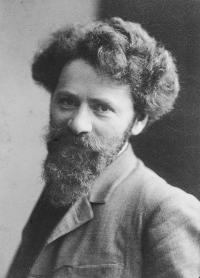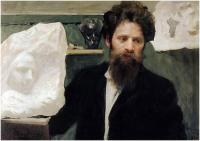Biography Naum Aronson 1872-1943
Naum Aronson Lvovich (1872-1943) was born on December 25, 1872, in a traditional religious family of ten children in Kreslavka, a village near Vitebsk in Bearus, then part of the Russian empire, now part of the Republic of Latvia. Aronson recalled “There are some memories that remain tangible forever like tastes and smells.” Naum was living in a ‘huge House”. Naum added that “The house the yard, the garden, the buildings came to life on Passover Eve.” He died in New York September 30, 1943.
Latvia regained its independence and became part of the European Community in 2004. Jews settled in that region in about 1765. They worked in commerce, crafts, and agricultural trade. The Jews were expelled by the Russians during WWI. In the summer of 1941 the Jews were taken to the town square. Some were taken outside of the town and shot, and their bodies burned. The Latvian mayor and Latvian auxiliary police helped the Germans. The remaining Jews were taken to the Dvinsk ghetto. “The theme of Jewishness is omnipresent in his work.” (Glants, p. 8)” Like many Jewish artists, Aronson’s relationship to Russia was complex and contradictory.” He kept Russian friends such as Konstantin Korovin and Boris Kustodiev.


Sculpting from an early age as a self-made sculptor, Naum left Home at 16 years old. He enrolled at the art drawing school of Ivan Trutnev in Vilna. He came back home after 10 months because of anti-Semitism expressed by the director of the program. He stayed two years and decided to move to Paris. Naum moved to Paris in 1891 to attend the school of Decorative Arts. In his diaries Naum said “I arrived in Paris without any knowledge of the language..,but with great energy and hopes that I would not die of Hunger”. He also attended the studio of Professor H. Lemaire and the Colarossi Studio. Aronson had always been acutely aware of people’s facial expressions “I can see the men, my grandfather and father with their clear faces that had shed their everyday masks.” (Glants, p. 11) In 1894, Aronson return to Russia to do his military service. Two years later he was back in Paris and Naum picked up his career where he had left it.
Aronson was known for his innate goodness. “When World War II broke out and a wave of refuges poured into Paris from Poland and Germany, Aronson tried to help them all in every way he could. Many had fond memories of the public refugee cafeteria called The Friendly Center, where Aronson and his wife worked unstintingly from the start of the war until their evacuation.” (Glants, p.9) In 1940 after the French occupation, Aronson and his wife fled to Portugal with Chagall and to the United States with the help of aid from HIAS [Hebrew Immigrant Aid Society and JDC [American Jewish Joint Distribution Committee]. “One American magazine even greeted his arrival in America with an article entitled ‘Hitler’s Latest Gift to America.” (Glants p. 7c)
He became known for his talent of capturing a person’s true spirit in sculpture. “Indeed, no matter which period of his life he is recalling, Aronson is able to conjure up its specific flavor; it is this that makes his observations of interest to people in many walks of life.” (Glants, p. 10). In August 1901, Aronson was commissioned to do a sculpture of Tolstoy. He traveled to the village of Yasnay Polyana, Russia, in order to meet Tolstoy and his family. Aronson said: “I had great hopes and ambitions but would never have aspired to sculpt the gods-for that is what Tolstoy was for me. Even to approach him seemed blasphemous.”
Aronson returned to Paris with a clay model and over sixty sketches of Tolstoy. “It was as he sat in this chair in the semi-darkness, that I used every opportunity to jot down his expressions – of weariness, pensiveness, and sometimes dissatisfaction.” (Glants, p. 21). He refined the sculpture of Tolstoy in 1901-1902, Aronson casted the bust in bronze at the Alexis Rudier Fondeur. The work was exhibited at the Fine Arts Academy in St Petersburg in 1902 to immense acclaim; the critics in agreement said that it truly captured Tolstoy. “He is no longer with us, but his great spirit and his immortal thought remain. This is what I wanted to convey – the Mont Blanc of the Russian land…The drawing of Tolstoy sitting in his armchair – that is how I saw him; Plunged in thought as he listened to the music.” (Glants, p. 21)





Aronson also made a clay model of Tolstoy’s wife, Sofia Andreevna. Aronson mastered the “delicate forms of the female body”. (Glants, p.9) As a deeply contemplative philosopher Aronson felt a close connection to the Russian people and culture, but anti-Semitism kept him from returning permanently. “Just as Aronson belongs to no single artistic movement, so, too, he belongs to no single country.” (Glants, p. 10) Naum’s studio was located rue de Vaugirard in Paris. Sacha Kolin, an abstract painter and sculptor, studied in the atelier of Naum Aronson but also Maud Sumner. Aronson Met in Saint Petersburg Miriam Berlin when he was commissioned to do a portrait of Rasputin. Marc Chagall, Chaim Soutine and Mane Katz were one of many visitors to Aronson’s Studio. In 1908, Naum noticed Chaikov(Tchaikov) and helped him moved to Paris. Naum worked around 4 to 5 am. He was also an avid writer, however most of his notes remained unpublished and they were destroyed during the German occupation.
In an article published by A.V. Lunac A.V. Lunacharsky titled, Revolutionary Silhouettes, Lunacharsky said that he contacted his friend, Aronson, to meet Lenin in Paris. Lenin spent four years in Paris (1909–1912): “Catching sight of Lenin’s head Aronson was enraptured and begged Lenin to allow him at least to sculpt a medallion of his head. He pointed out to me the amazing resemblance between Lenin and Socrates. I should add, incidentally, that Lenin bore a much closer likeness to Verlaine than to Socrates.” Miriam Berlin (1888–1974) a woman sculptor born in St. Petersburg met the sculptor Naum Aronson(1872–1943), who had been invited to sculpt a portrait of Rasputin in
St. Petersburg.
Naum’s art was influenced by Michelangelo and Rodin, although his work “cannot be confined within any single trend or style.” (Glants, p.8) Aronson “used simple means to achieve simple results. No matter what materials he used, even those which are difficult to work with like black marble and ivory, he felt completely free and always liked to put the finishing touches to the work himself.” (Glants, p. 9) His sculpture depicts mainly Jewish biblical figures and different personalities such as Louis Pasteur, Tolstoy, Belinsky, Turgenev, Rasputin, Lenin, George Washington, Beethoven (the sculpture now in front of Beethoven’s home in Bonn), Chopin and Berlioz. As well as his sculptures in museums, his fountains can be found in the Place de la Concorde in Paris and in Gedesburg, a small German city.
He exhibited his work at the Salon du champs de Mars and Naum became a jury member of the salon. His work was also exhibited at the International Exhibition in 1900. He got a gold medal prize in Liege. He was granted France’s highest award, the Legion of Honor, in 1937 for his work at the “Exposition Universelle.” (Glants p. 7)
The acquisition of Naum Aronson’s sculptures by The Petach Tikva Museum of Art is a fascinating episode: “The initiative was set in motion by David Tabachnik, Deputy Mayor of Petach Tikva late in 1952. During a trip to France on behalf of the Zionist Organization that year, Tabachnik arrived at a children’s home in the Andelys village,80 km. from Paris, where Jewish children, Holocaust orphans, were placed. Upon his arrival he noticed children throwing stones at some sculptures scattered around. After the Nazi occupation of Paris, the Nazis decided to confiscate a large portion of the treasures at the Louvre and transfer them to Germany. The sculptures were loaded on a train headed to Berlin, but the French engineers managed to prevent the transition of the artifacts by routing the train throughout France for 40 days. When the train finally stopped in one of the French villages, the artworks, including Aronson’s sculptures, were unloaded, clandestinely handed over to the French Resistance and subsequently transferred to the children’s home in Les Andelys. In Israel “his name is known and highly esteemed. Over a dozen of his works were donated by his widow to the Yad-Labanim Museum in the town of Petach-Tiqva.” (Glants, p. 10).
- Experiment Centrifuge: Memoirs, Letters and other Documents from the Era of Russian Modernism. Volume I, 1995. Naum Aronson: About my childhood. Portraits of my family, My Home , Musya Glants.
- Experiment Centrifuge: Memoirs, Letters and other Documents from the Era of Russian Modernism. Volume I, page 13, 1995. Naum Aronson: About my childhood. Portraits of my family, My Home , Musya Glants.
- M Dluzoovski,”Hitler Latest gift to America” The Jewish Pictorial Voice New York. Jan,Feb 1943,p.7.
- Autour de l’art juif: encyclopédie des peintres, photographes et sculpteurs by Adrian M. Darmon, 2003, page 309.

Exhibition
1937 Paris, – world fair Bust of Lenin was exhibited at the Soviet pavilion at the 1937 World Fair in Paris.
1935-1938 he worked on the busts of “Drummer” and “Udarnitsa” for the Moscow Metro.
1926- Galery Decour, one man show exhibition
1924-1925 San Francisco, USA1924-1925, French art in the California
Palace of the Legion of Honor Lincoln Park, San Francisco
1922- 1st Exhibition of Sculptures, Academy of Arts. Exhibition Catalogue
Saint Petersburg: Committee of Sculptors of Sorabis, 1922[Sculpture by Boris
Kustodiev, Dmitry Stelletsky, Mikhail Vrubel, Naum Aronson, Gugo
Zaleman, Vladimir Beklemishev].
1914-went to Saint Petersburg to install a bust of the actress, Vera Komissarzevskai in Alexandrinsky Theater.
1906-1938 Salon de la Société Nationale des Beaux-Arts.
1906- Goupil Gallery, London: Summer exhibition of pictures by
British, French and Dutch artists, including a selection of statuary
by Naoum Aronson of Paris.
1905-Liege Exhibition, Belgium, Naum received a Gold Medal.
1902 Fine art
1901-Berlin
1900-Paris “:Exposition Universelle”, Naum received a Gold Medal.
1897 Salon du Champs de Mars

MUSEUMS:
-Bonn,
-Geneva, Switzerland: Petit Palais.
-Moscow, State Lenin Museum
1930 bust of Vladimir Lenin by sculptor Naum Aronson.
-Moscow, -State Tretyakov Gallery, Moscow.
– Paris, Institut Pasteur: Bust of Louis Pasteur by Naum Aronson, 1920-1922
– Paris Musee du louvre, [Musee du Luxembourg], Douleur de Salome, Exhibited at the salon in 1920.
-St. Petersburg Russian Museum, Grief.
Scuplture of Louis Pasteur was commissioned to celebrate the century of Pasteur’s birth and 16copies were commissioned to cities around the world.
BOOKS/ARTICLES – S. A. Tolstaya, Diary 1897-1909; V. Lakshin, Odesskiy listok, with Aronson’s notes about his visit to Yasnaya Polyana in August 1901 -:1911-DANILOWICZ C.”Naoum Aronson, sculpteur”, Paris. -N. Aronson, unpublished memoirs written in Russian and French, 1930’s.Unpaginated Manuscripts in the possession of Ellen Aronson, New York. All translations from the French have been rendered by Ellen Aronson. – Jewish artists of the 19th and 20th centuries Philosophical Library, 1949 – Art – 273 pages. Naum, page 118. – Experiment Centrifuge: Memoirs, Letters and other Documents from the Era of Russian Modernism. Volume I, 1995. Naum Aronson: About my childhood. Portraits of my family,My Home. Introduction: Nam Aronson by Musya Glants. – Regions of the Great Heresy: Bruno Schulz, a biographical portrait / Jerzy Ficowski ; translated and edited by Theodosia Robertson, Naum Aronson p111 New York: W.W. Norton, 2003.